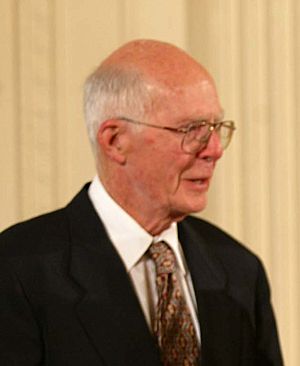Raymond Davis, Jr. facts for kids
Quick facts for kids
Raymond Davis, Jr.
|
|
|---|---|

Davis in 2001
|
|
| Born | October 14, 1914 Washington, D.C., USA
|
| Died | May 31, 2006 (aged 91) Blue Point, New York, USA
|
| Nationality | United States |
| Alma mater | University of Maryland Yale University |
| Known for | Neutrinos |
| Awards | Comstock Prize in Physics (1978) Tom W. Bonner Prize (1988) Beatrice M. Tinsley Prize (1994) Wolf Prize in Physics (2000) National Medal of Science (2001) Nobel Prize in Physics (2002) Enrico Fermi Award (2003) |
| Scientific career | |
| Fields | Chemistry, physics |
| Institutions | Monsanto University of Pennsylvania |
Raymond (Ray) Davis, Jr. (October 14, 1914 – May 31, 2006) was an American chemist and physicist. He won the Nobel Prize in Physics in 2002. He received this important award for his work on detecting tiny particles called neutrinos from the Sun. His famous experiment, known as the Homestake Experiment, helped solve a big puzzle in science. He was 88 years old when he received the prize.
Davis, Jr. passed away in Blue Point, New York, at the age of 91.
Contents
Who Was Raymond Davis Jr.?
Raymond Davis, Jr. was a brilliant scientist. He was born in Washington, D.C., in 1914. He studied both chemistry and physics. These two fields helped him understand the world around us. He worked at places like Monsanto and the University of Pennsylvania.
His Big Discovery: Neutrinos
Ray Davis, Jr. is best known for his work with neutrinos. Neutrinos are incredibly tiny particles. They have almost no mass and no electric charge. They travel at nearly the speed of light. Billions of neutrinos pass through your body every second! Most of them come from the Sun.
Scientists knew the Sun produces neutrinos. But they couldn't detect as many as they expected. This puzzle was called the solar neutrino problem. It made scientists wonder if their understanding of the Sun or neutrinos was wrong.
The Homestake Experiment
To solve this puzzle, Davis built a special detector. It was part of the Homestake Experiment. This experiment was deep underground in a gold mine in South Dakota. Being deep underground helped block out other particles. This way, only neutrinos could reach the detector.
The detector used a huge tank filled with cleaning fluid. This fluid contained a lot of chlorine. When a neutrino hit a chlorine atom, it would change into a different atom. Davis counted these new atoms. This told him how many neutrinos were passing through.
Solving the Solar Neutrino Problem
Davis's experiment showed that fewer neutrinos were reaching Earth than expected. This confirmed the "solar neutrino problem." His work helped other scientists realize something important. Neutrinos can change their "flavor" or type as they travel. This means some neutrinos were changing into types his detector couldn't see. This discovery was a huge step forward in physics. It showed that neutrinos have a tiny bit of mass.
Awards and Recognition
For his groundbreaking work, Raymond Davis, Jr. received many awards. The most famous was the Nobel Prize in Physics in 2002. He shared the prize with two other scientists. His work helped us understand the Sun and the universe much better.
Images for kids
See also
 In Spanish: Raymond Davis Jr. para niños
In Spanish: Raymond Davis Jr. para niños


